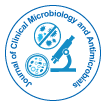
Journal of Clinical Microbiology and Antimicrobials
Open Access
+44-77-2385-9429

+44-77-2385-9429
Perspective - (2024)Volume 8, Issue 2
Catheter-Related BloodStream Infections (CRBSIs) represent a significant healthcare challenge, characterized by their association with substantial morbidity, mortality, and economic burden. These infections arise from the colonization of catheters by bacteria or fungi, leading to subsequent bloodstream invasion. Understanding the pathogenesis and identifying key risk factors are necessary steps towards effective prevention and management strategies.
Pathogenesis of CRBSIs
The pathogenesis of CRBSIs involves a sequence of events starting with the colonization of the catheter surface by microorganisms. Catheters provide an ideal substrate for microbial adherence and biofilm formation due to their foreign material and prolonged contact with bodily fluids. Biofilms, composed of microbial communities encased in extracellular polymeric substances, shield bacteria and fungi from host defenses and antimicrobial agents.
Once established, biofilms facilitate the continuous shedding of planktonic microorganisms into the bloodstream, perpetuating the infection. This mechanism not only complicates treatment but also increases the risk of systemic complications such as sepsis and endocarditis. The ability of pathogens to adhere to catheter surfaces and form biofilms varies with microbial species, catheter material, and host factors, underscoring the multifaceted nature of CRBSI pathogenesis.
Bacterial and fungal colonization
Bacterial colonization predominates in CRBSIs, with Staphylococcus aureus, Coagulase-Negative Staphylococci (CoNS), Enterococcus species, and gram-negative bacilli being the most frequently isolated pathogens. These organisms possess virulence factors facilitating adherence and biofilm formation, increasing the challenges in managing CRBSIs effectively. Moreover, the emergence of multidrug-resistant strains further complicates treatment options, necessitating judicious use of antimicrobial agents and innovative preventive measures.
Fungal colonization, although less frequent, is increasingly recognized as a significant contributor to CRBSIs. Candida species, particularly Candida albicans and non-albicans Candida, adhere to catheters and form biofilms, presenting a formidable clinical challenge due to their intrinsic resistance mechanisms and limited antifungal options. The shift towards fungal etiology underscores the importance of broad-spectrum antifungal prophylaxis in high-risk patients, such as those in intensive care units or with prolonged hospital stays.
Risk factors contributing to CRBSIs
Several factors predispose patients to CRBSIs, surrounding both host-related and catheter-related variables. Host-related factors include immunosuppression, comorbidities (e.g., diabetes mellitus), and extremes of age, understanding the immune response and enhancing susceptibility to infection. Catheterrelated factors such as catheter type, insertion technique, duration of catheterization, and hub colonization play pivotal roles in microbial adherence and subsequent bloodstream invasion.
Effective prevention strategies hinge on addressing these risk factors through stringent catheter care protocols, including aseptic insertion techniques, regular site care, and catheter removal when no longer necessary. Additionally, the development and implementation of antimicrobial-coated catheters and novel biomaterials aim to mitigate biofilm formation and reduce infection rates.
CRBSIs represent a complex exchange of microbial colonization, biofilm formation, and host susceptibility. Effective management necessitates a comprehensive understanding of pathogenesis, vigilant surveillance, and proactive implementation of preventive measures. Future research focusing on innovative therapeutic approaches and targeted prevention strategies holds potentially in reducing the burden of CRBSIs and improving patient outcomes in healthcare settings worldwide.
Citation: Raphle Z (2024) Pathogenesis and Risk Factors of Catheter-Related Bloodstream Infections: Bacterial and Fungal Colonization. J Clin Microbiol Antimicrob. 8:189.
Received: 14-May-2024, Manuscript No. JCMA-24-31985; Editor assigned: 17-May-2024, Pre QC No. JCMA-24-31985 (PQ); Reviewed: 03-Jun-2024, QC No. JCMA-24-31985 ; Revised: 10-Jun-2024, Manuscript No. JCMA-24-31985 (R); Published: 17-Jun-2024 , DOI: 10.35248/jcma.24.8.189
Copyright: © 2024 Raphle Z. This is an open-access article distributed under the terms of the Creative Commons Attribution License, which permits unrestricted use, distribution, and reproduction in any medium, provided the original author and source are credited.